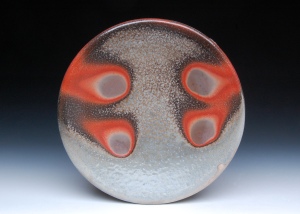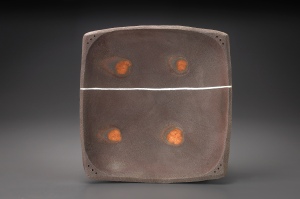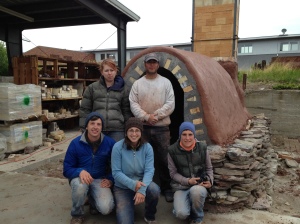For the month of July…I am pleased to introduce Simon Levin! I have admired Simon’s work and his writing for years and feel fortunate to have him contribute to the series.
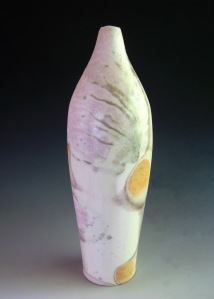 I am particularly fond of Simon’s rich, layered surfaces and swelling, volumetric forms. His bottles are among my favorite forms being made today. I love the way that they appear to anticipate use…how they seem almost incomplete without the proper surround or the ideal bloom. They are so subtle and graceful…a narrow base that expands slightly as it lifts to the shoulder before tapering back in to a narrow opening at the rim. And the drama of the wood ash rolling around the form…perfection!
I am particularly fond of Simon’s rich, layered surfaces and swelling, volumetric forms. His bottles are among my favorite forms being made today. I love the way that they appear to anticipate use…how they seem almost incomplete without the proper surround or the ideal bloom. They are so subtle and graceful…a narrow base that expands slightly as it lifts to the shoulder before tapering back in to a narrow opening at the rim. And the drama of the wood ash rolling around the form…perfection!
Enjoy the interview!
How did you first get involved in ceramics? Can you briefly describe your background and education? I have a bachelor’s degree in Psychology. I took a lot of art classes through high-school but went to college thinking of a career in criminal law. I continued to take art in college and was discouraged from double majoring. I was told that the required classes for a double major would keep me from taking the art classes I wanted. It made sense, and in retrospect Grinnell College gave me a wonderful education but majoring in art there would not have prepared me for an MFA.
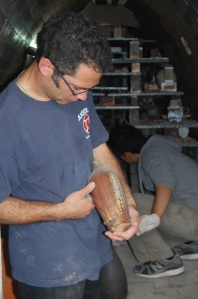 How do you feel that your formal education (undergraduate-graduate school) prepared you for your career in ceramics? Ok, I just said that my formal education didn’t prepare me for an MFA, and I stand by that. 5 years and three rounds of applications to graduate schools later I was finally accepted at one of the 4 schools I applied to. It took me a long time to figure out how to take slides (We didn’t have images back then) and how to build a portfolio. It took even longer to figure out how make work that made sense, had a voice and vocabulary. Grinnell didn’t prepare me for that.
How do you feel that your formal education (undergraduate-graduate school) prepared you for your career in ceramics? Ok, I just said that my formal education didn’t prepare me for an MFA, and I stand by that. 5 years and three rounds of applications to graduate schools later I was finally accepted at one of the 4 schools I applied to. It took me a long time to figure out how to take slides (We didn’t have images back then) and how to build a portfolio. It took even longer to figure out how make work that made sense, had a voice and vocabulary. Grinnell didn’t prepare me for that.
What Grinnell did was prepare me for my career in ceramics. I learned how to learn. I learned how to write and organize my thoughts. I became articulate in english and that has helped tremendously in my journey to become articulate in clay. Writing has been great marketing and promotion, it has helped get my name out there in the world. Articles have legs. They stay out there in the community and reach people in unexpected times and places. It is odd to realize that even though I used to hate assigned readings I am now told by teachers that they assign my articles.
How do you come up with new ideas? Can you walk us through your creative process when coming up with new forms/ideas? Coming up with new ideas seems to be part of the process. When the studio is at its best it is like a conversation, playful and flowing. Ideas come out of that flow, rather than being imposed from outside. This keeps them from being contrived. After a firing cycle it takes days to get back into the rhythm of the studio, for the issues to come alive again. Then play starts from that easy comfortable place.
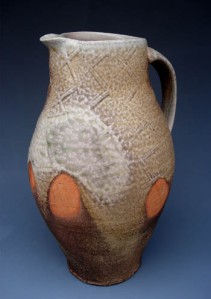 Play is usually simple stuff. I try a different slip on a cup, or a new pattern on a paddle. I layer information, brush textures over paddled textures. Play is often the act of wondering what if, or I would like to see that. That play leads me to a larger repertoire of results. Then I can analyze the results and figure out if and how I might like to use them.
Play is usually simple stuff. I try a different slip on a cup, or a new pattern on a paddle. I layer information, brush textures over paddled textures. Play is often the act of wondering what if, or I would like to see that. That play leads me to a larger repertoire of results. Then I can analyze the results and figure out if and how I might like to use them.
Occasionally ideas do come from the outside. And at first they can be awkward, cliched, or contrived. It is the continual discovery and investment in them, the involvement and development that moves these new outside ideas into rich personal concepts.
You’ve written a handful of insightful articles for our field. One of my favorites is called “Becoming Inarticulate”, which you wrote for Studio Potter (June 2007). In the article you talk about communicating content (not style) through handmade pottery. I find this is a complex idea to teach beginning students who are concerned about finding their personal style. What kind of advice could you offer someone who’s trying to decide what to say with his/her work? Interesting to hear that this is one of your favorites. It was the hardest for me to write, and perhaps the article I feel most unsatisfied with. I was trying to talk about how when you learn the language of clay your vocabulary is non verbal, it is physical and spatial. And the more I make pots and use clayish phrasings the harder it is to talk about in english. In a way it was like grabbing smoke, a hard task, at best you can get the smell on your hands but even that is kind of ethereal. Essentially much of my work is about the material and the process so the way to talk about it isn’t to translate directly but rather to invite a person into the process and show them where on the pots they would see evidence, results or narratives of these processes.
FInding one’s voice in clay is key in contemporary American ceramics. Unlike some cultures who stress tradition, we emphasize innovation. What I didn’t understand when I was starting in clay is that innovation will come on it’s own. I believe style to be a byproduct of interest. The beautiful news is that in order to decide what you want to say with your work, you have to follow your interests. Watch how you respond. Identify what inspires you. What are you making that you want to come back to? What keeps you in the studio?
There are some confounds to this. There are lots of pots that inspire me, but I cannot make them nor should I. My apprentice Lucy, wanted to make loose soft pots, but in the studio she was happiest working on detailed, refined, fiddly work. The making process is different than the appreciation process. The best we can do is be honest and present in our work and try and see what we have made without desires or preconceptions. Then take that information into our awareness as we make the next round of work.
You also wrote a poignant and humorous article called “Critical Care: The Art of Self Critique”(Ceramics Monthly, Aug/Sept 2006). Can you talk a little bit about the importance of critical analysis as part of your creative practice? Oh, my. Well I start out that article saying that critical analysis is the one tool I use in the studio every day. It is the way I get closer to becoming articulate in clay. Knowing what I want to say is not enough. Critical analysis is the stepping back and seeing what I have said, and assessing if I have said it well. It is editing out areas of miscommunication. It is highlighting and reiterating the themes that I want. It is the only way I know to get better. That being said Critical analysis happens after the act, never during. The act of making needs to be pure and intuitive and in the moment.
 You have built numerous kilns across the world. Can you talk a little about the kiln building process (from design to completion)? What advice would you offer to someone wanting to build his/her own kiln? Kiln building was a necessary skill set to learn once I decided to become a potter. It was a way to build the kilns I would need, and a way to increase the intimate connection I wanted to have with the work. Firing the first kiln I built was wonderful, there was a moment when the kiln was hotter on one side than the other, and we were able to compensate by opening passive dampers on the hot side and sliding the active damper aperture towards the cold side of the kiln. The solutions for firing issues had been anticipated in the kiln design. It was a glimpse towards mastery where all steps in a process made room for that which precedes and that which had yet to come.
You have built numerous kilns across the world. Can you talk a little about the kiln building process (from design to completion)? What advice would you offer to someone wanting to build his/her own kiln? Kiln building was a necessary skill set to learn once I decided to become a potter. It was a way to build the kilns I would need, and a way to increase the intimate connection I wanted to have with the work. Firing the first kiln I built was wonderful, there was a moment when the kiln was hotter on one side than the other, and we were able to compensate by opening passive dampers on the hot side and sliding the active damper aperture towards the cold side of the kiln. The solutions for firing issues had been anticipated in the kiln design. It was a glimpse towards mastery where all steps in a process made room for that which precedes and that which had yet to come.
When I was a TA in grad school I grouped my beginning ceramics students into teams of 4. Their mid-term exam was to get their pots from green ware to bisque without using a pre-existing kiln. I turned them loose on the kiln yard and all the broken brick, and shelving. Though they could have pit fired, they all built kilns. The kilns were all wrong. A roof of one of the the kilns was made by leaning two broken shelves together which made me hugely nervous. Everything I knew about kiln building told me that you can’t do that. They all worked. All the students passed. All the pots got to bisque and higher. All this to say go ahead, build. Bricks are reusable and the knowledge gained invaluable..
What is your most valuable studio tool? Why? Critical Analysis. See response to critical analysis question above.
Which marketing venue(s) (website/blog/galleries/studio sales/etsy/craft fairs/etc.) have you found to be the most lucrative for your work? Home Studio tours. I have never been involved in anything that compares to the Minnesota Potters tour. Minnesotapotters.com. Sales there have been a magnitude or more higher than anywhere else I have sold. We host our own home studio tour here as well and will be starting our fourth year.
One NCECA I went to a terrible presentation on promotion although this idea has stuck with me. Essentially people are looking for authenticity, the intimate experience. Home studio tours do this really well. Guests meet the potters, see where they work, they might get to see them work. Guests learn about the process, and they leave with an understanding that enriches the experience of utility. The following year they might bring a friend and now they have ownership. They are the tour guide welcoming someone new into their discovery.
The Minnesota potter’s tour works better than any other because it is established, but the customers are so well educated about functional ceramics. Generations of education, a cultural valuing of the hand made, and a large metro population feed the tour. The potter’s who organize it realized that more potter’s means more pie. They invite potters from around the country and this once a year coalescing of some of the best functional clay in the United states draws in visitors from far and wide. I don’t ever expect our own tour here in rural Wisconsin to compete but it is growing and the investment builds.
Amy Smith and you have been collaborating with each other for years. Many exhibitions have showcased these collaborative conversations and an article called “Paired Views” was published in Ceramics Monthly (March 2013). The collaborative pieces that I’ve seen are so incredibly poetic. What have you gained from the experience that surprised you? The collaborative process was really revealing. It helped me see my own work better, and opened new ideas and possibilities
that I would have never considered or even come to on my own. Amy and I set out to make pairings that made room for one another while maintaining individual voice and expression. We wanted the pieces to stand alone but belong together. It is a challenging goal. I feel as though we were successful in that endeavor. The University of Nebraska-Lincoln hosted a show called Emulsion that was the culmination of that goal, and Akar’s show Layered is an opportunity to own the pairings. I have yet to come across another collaboration quite like this.
You have a remarkable apprenticeship program that you started in 2004. Can you talk a little bit about your program at Mill Creek Pottery and what the experience can offer someone wanting to make a career in the field? The apprenticeship program has grown. It has been exciting and challenging for me to work with younger folks who are committed to the field. In many ways the apprenticeship program I built is exactly what I would have wanted at that time in my life. Opportunities, facilities, information and guidance, but with the freedom to make what I wanted.
In some ways I think the apprenticeship is a reality check. I don’t really provide a clay community. We are a small operation and some of the days are long and quiet. Apprentices often get a little lonely. Being in the studio day after day is not for everyone. The romance of wood firing tarnishes a little in -2 degree weather.
The apprenticeship is also not school. It takes some apprentices time to realize that I have high expectations of them but they are not making work to please me. There isn’t a right answer. There is work, and consideration, conceptual development and discovery. I want them to tell or show me what they are excited about not try and make something that I would make, or excites me. The benefit of it not being school though is that when I teach workshops, travel, discuss business, interact with galleries and customers the apprentices are involved and learn from those non academic real life experiences.
I didn’t see this when I started the apprenticeship program but it is wonderful being connected to some great young potters who are contributing to the field. My apprentices in reverse order with links have been:
Willson Gaul, Kelsie Rudolph, Lucie Brisson, Hannah Meredith, Mike Gesiakowski, Chaio-Feng Shen, Ryan Strobel, Matt Bukrey, Tom Jaszczak, Chris Greenwood, Kenyon Hansen and Domonique Venzant.
 You are involved in a lot of daily activities aside from studio work. Can you talk about how you are able to balance family/studio/etc. and how these outside responsibilities help to “keep you from being single-minded in clay”? Balance. What is this balance of which you speak? There was a firing years ago when I was preparing for my first sale at Karen Karne’s curated show at the Art School at Old Church. I was pushing too hard, and had pneumonia going into the firing. I remember thinking that woodfiring was going to kill me. I made it through the firing and tried to rest during the cooling, then with cleaning up of pots and driving to and from New Jersey I ended up getting shingles. Although it didn’t lay me out, it was painful and I had to endure the ridicule of friends telling me I had an old lady disease. Life was more than a little out of balance.
You are involved in a lot of daily activities aside from studio work. Can you talk about how you are able to balance family/studio/etc. and how these outside responsibilities help to “keep you from being single-minded in clay”? Balance. What is this balance of which you speak? There was a firing years ago when I was preparing for my first sale at Karen Karne’s curated show at the Art School at Old Church. I was pushing too hard, and had pneumonia going into the firing. I remember thinking that woodfiring was going to kill me. I made it through the firing and tried to rest during the cooling, then with cleaning up of pots and driving to and from New Jersey I ended up getting shingles. Although it didn’t lay me out, it was painful and I had to endure the ridicule of friends telling me I had an old lady disease. Life was more than a little out of balance.
I play pick up games of soccer once a week. The teams are usually dominated by highschoolers. Some of them are so fast and skilled. But I play well using what my first apprentice Domonique called “Old-man muscle”. Essentially playing smart, being in the right place at the right time, using focused force and not expending excess energy. In the studio now I plan ahead, I delegate, I use my apprentice’s time well. I work backwards from deadlines. I try and be highly organized. It is a constant discipline. I also am more forgiving when I cannot make a deadline.
Finally, what advice can you give aspiring potters trying to make a living? Inherit money, marry money, or document. Nothing sells like a story, and the journey to become established as a full time artist is compelling in and of itself. There seems to be this compulsion to wait till the work is impeccable, and then emerge on the scene as a fully formed voice in the clay world. It takes time to learn how to market. It takes time to get your name out there. Start now.
Learn how to approach a gallery. Learn how to market. Learn how to use social media effectively. Write about your work. Learn how to take great images of your work. Outline the skill sets you will need. Kiln building, writing, carpentry, photography, promotion. Take workshops, and ask these questions. Read Jen’s blog and look at other models for how other potters have made their career’s work. Call those people up and ask them the parts you don’t understand. Don’t call me of course, but feel free to contact the other potters of the month. Attend panel discussions, or organize panel discussions on the topics you want to know about. Market to your acquaintances not just to your friends. Start a mailing list now, today.
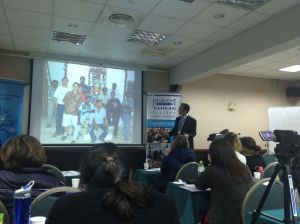 I have found writing to be one of the most powerful marketing tools. Not only do I often get paid for it but it gets my name and ideas out there. It is a gateway for people who don’t speak clay to learn about and connect with your work and your journey. Writing makes you a resource to others and lifts the community up.
I have found writing to be one of the most powerful marketing tools. Not only do I often get paid for it but it gets my name and ideas out there. It is a gateway for people who don’t speak clay to learn about and connect with your work and your journey. Writing makes you a resource to others and lifts the community up.
Jen Allen’s blog with a potter of the month is a brilliant idea, the success of her blog is tied to other’s self interest. I will promote that I am featured, in turn I will be promoting her. All the previous featured potters have done the same. The circle of fans that Kristen Kieffer draws has some overlap with those who follow my work, but probably not much. I gain from those who have started to follow Jen’s Blog before I was featured. Jen becomes a resource of information, a hub that lifts and promotes the clay community. In this symbiotic way of being tied together we all gain.
To find out more about Simon and his work, please visit his website:

